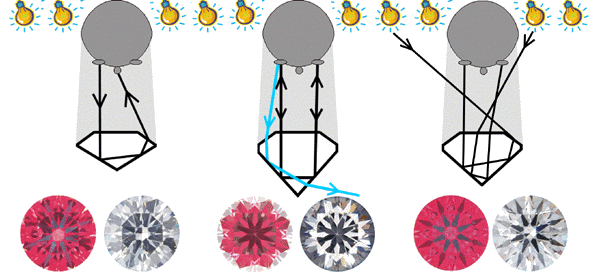BETTER YIELDS
Ideal-Scope diamonds can be made into a very wide range of proportions. This means that you have a lot more options to plan each piece of rough.
Research Findings
GIA, AGS and MSU scientists all agree that diamonds with shallow crowns and deeper pavilions, and vice a versa, look good.
For example a 30° crown and 41.7° pavilion or a 37° crown and 40° pavilion. What does not work is 30° crown and 40° pavilion (like the stone on the left) or 37° crown and 41.7° pavilion.

On the left is a shallow diamond that appears very dark through an ideal-scope. The central diagram shows a deep ‘nail head’ diamond with a dark center. The Ideal-Scope white outer facets show strong leakage; these will look dark when the diamond is set. The stone appears dull and small for its weight. The diamond on the right hand side is an ideal-cut.
You probably know diamonds cut like this look great, but if you send them to grading labs they will get bad proportion grades or GIA crown angle warnings. Now, for the first time, there is a way to sell beautiful unusual cuts; there are labs who will take an Ideal-Scope photo and print it on the grading report, without the proportions. This is ethical if the report has an Ideal-Scope photo because a good ideal-scope image guarantees a beautiful diamond. For a consumer the proportions are too confusing anyway.
The proportions that make nice Ideal-Scope diamonds are in the red zone on the HCA chart. You can see that mid sized tables, about 57%, give the biggest range of good proportions, but you will still get good results up to 62% or down below 54%.
Bigger tables, shallow crowns and slightly deep pavilions will get a better yield with flat stones, like sawn tops and flat makeables. Smaller tables, steeper crowns and shallow pavilions work best with stones sawables and rounded makeables. More on that in the section on Sarin and other scanners for planning.
